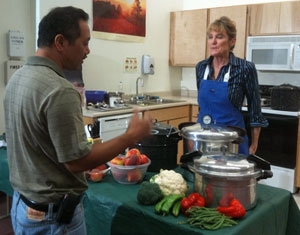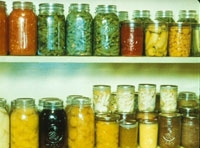Whether to save money or to dine on fresher products, more Californians have been buying locally grown food and growing their own lately. They also have started home canning what they can’t eat right away. But be aware that if you put them up incorrectly, those garden goodies can be deadly.

Meats, vegetables and any food containing meats and vegetables -- such as salsa or spaghetti sauce -- have to be pressure-canned to prevent botulism, a paralyzing illness that can kill the person who eats the contaminated food. Botulism is caused by a nerve toxin produced by the bacterium Clostridium botulinum. A less serious consequence of not following a scientifically tested recipe is foodborne microorganisms can survive and spoil your canned foods.
I used to wonder why people would pickle green beans or cauliflower. They seemed like odd foods to pickle. Now I understand.
If you prefer to home can low-acid vegetables such as green beans using the boiling water bath instead of a pressure canner, you must first pickle the vegetables to ensure the final acidity is too high for Clostridium botulinum to grow.

“Certain foods, such as tomatoes, pears and figs, have a pH value close to 4.6 and must have acid added to them to lower the pH enough to use the water bath method,” Algert told me. “The pH can be lowered by adding commercial lemon juice or powdered citric acid.”
She added, “You can’t use juice squeezed from a fresh lemon that you picked from your backyard tree because we don’t know exactly how acidic the juice is. Commercial lemon juice meets a standard acidity.”
Here’s a general guide to help decide which canning method to use:
Low-acid foods that must be pressure canned:
- meats
- seafood
- poultry
- dairy products
- all vegetables
- combination products using these foods
High-acid foods that can be canned in boiling water bath:
- most fruits
- properly pickled vegetables
Foods that require added lemon juice for boiling water bath canning:
- figs
- pears
- tomatoes
For more information about safely canning food, visit the University of California’s Food Safety website at http://ucfoodsafety.ucdavis.edu/Consumer_Advice and the USDA National Center for Home Food Preservation website at http://www.uga.edu/nchfp.
UC also offers publications at http://ucanr.org/foodpreservation on other methods of safely preserving and storing foods, from apples to tomatoes.
Algert's home canning overview: